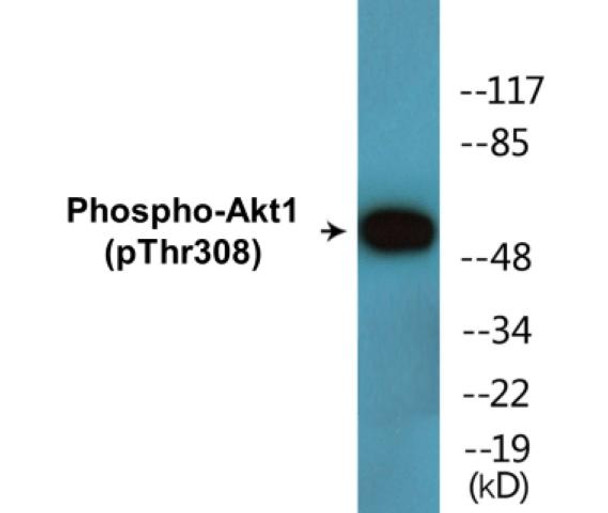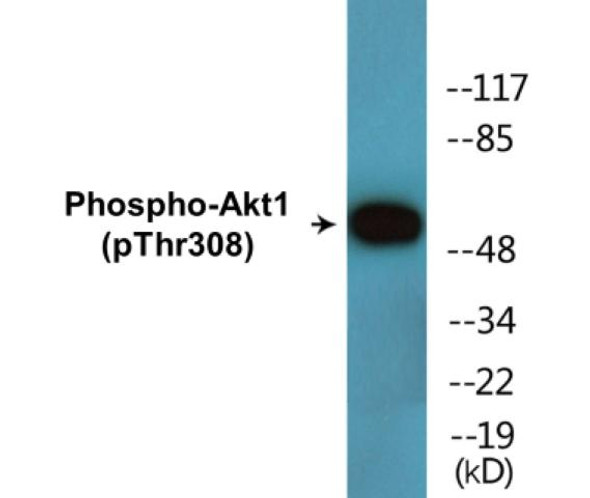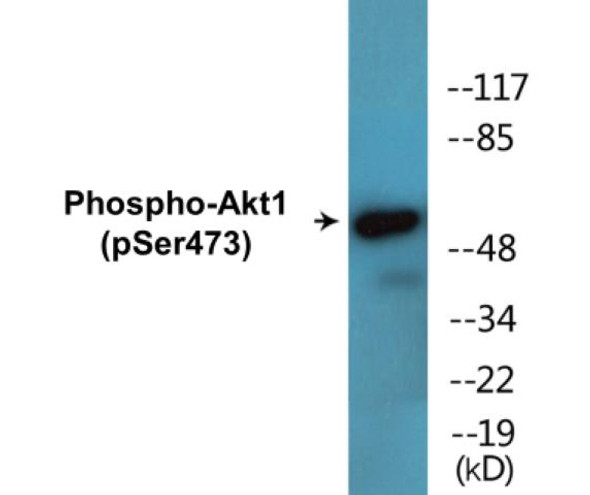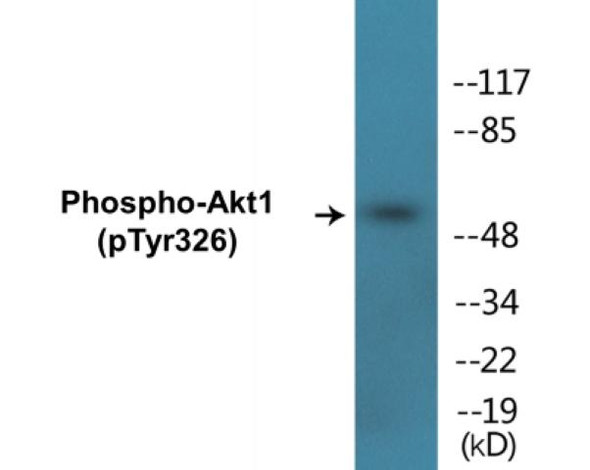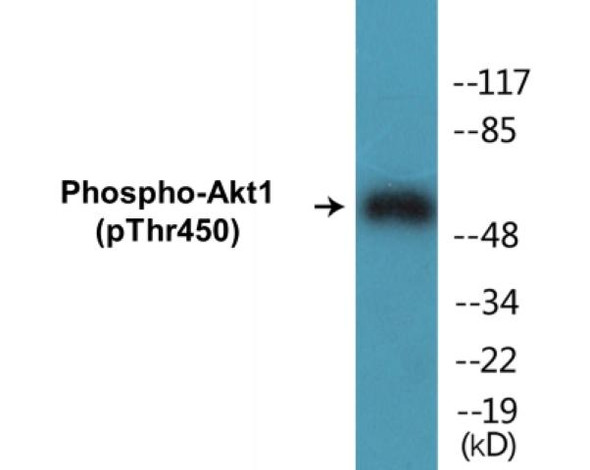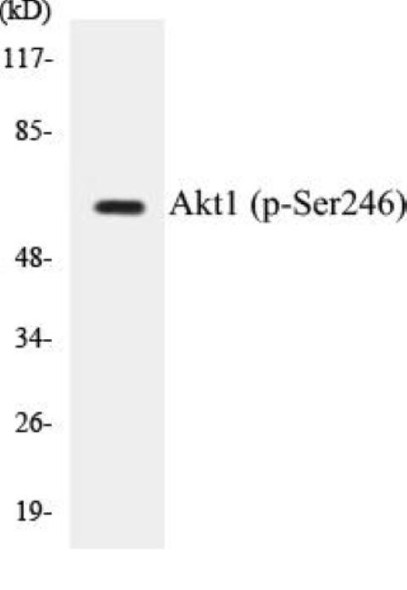Description
Akt1 (Phospho-Thr308) Cell-Based ELISA Kit
The Akt1 (Phospho-Thr308) Cell-Based ELISA Kit is a convenient, lysate- free, high throughput and sensitive assay kit that can monitor Akt1 phosphorylation and expression profile in cells. The kit can be used for measuring the relative amounts of phosphorylated Akt1 in cultured cells as well as screening for the effects that various treatments, inhibitors (ie. siRNA or chemicals), or activators have on Akt1 phosphorylation.
How does our Akt1 (Phospho-Thr308) Fluorometric Cell-Based ELISA Kit work?
Qualitative determination of Akt1 (Phospho-Thr308) concentration is achieved by an indirect ELISA format. In essence, Akt1 (Phospho-Thr308) is captured by Akt1 (Phospho-Thr308)-specific primary (1°) antibodies while Dye 1-conjugated and Dye 2-conjugated secondary (2°) antibodies bind the Fc region of the 1° antibody. Through this binding, the dye conjugated to the 2° antibody can emit light at a certain wavelength given proper excitation, hence allowing for a fluorometric detection method. Due to the qualitative nature of the Cell-Based ELISA, multiple normalization methods are needed:
| 1. | A monoclonal antibody specific for human GAPDH is included to serve as an internal positive control in normalizing the target RFU values. |
| 2. | An antibody against the nonphosphorylated counterpart of Akt1 (Phospho-Thr308) is also provided for normalization purposes. The RFU values obtained for non-phosphorylated Akt1 can be used to normalize the RFU value for phosphorylated Akt1. |
Akt1 (Phospho-Thr308) Fluorometric Cell-Based ELISA Kit -Information
| Product Name: | Akt1 (Phospho-Thr308) Fluorometric Cell-Based ELISA Kit |
| Product Code/SKU: | FBCAB00093 |
| Description: | The Akt1 (Phospho-Thr308) Fluorometric Cell-Based Phospho ELISA Kit is a convenient, lysate-free, high throughput and sensitive assay kit that can monitor Akt1 (Phospho-Thr308) protein phosphorylation and expression profile in cells. The kit can be used for measuring the relative amounts of phosphorylated Akt1 (Phospho-Thr308) in cultured cells as well as screening for the effects that various treatments, inhibitors (ie. siRNA or chemicals, or activators have on AKT1/AKT2/AKT3 phosphorylation. |
| Dynamic Range: | > 5000 Cells |
| Detection Method: | Fluorometric |
| Storage/Stability: | 4°C/6 Months |
| Reactivity: | Human, Mouse, Rat |
| Assay Type: | Cell-Based ELISA |
| Database Links: | Gene ID: 207/208/10000, UniProt ID: P31749, OMIM #: 164730/164731/611223, Unigene #: Hs.525622/Hs.631535/Hs.498292 |
| Format: | Two 96-Well Plates |
| NCBI Gene Symbol: | AKT1/AKT2/AKT3 |
| Sub Type: | Phospho |
| Target Name: | Phospho-Akt1 (Thr308) |
Kit Principle
Figure: Schematic representation of Assay Genie Cell-Based Fluorometric ELISA principle
Kit components | Quantity |
| 96-Well Black Cell CultureClear-Bottom Microplate | 2 plates |
| 10X TBS | 24 ml |
| Quenching Buffer | 24 ml |
| Blocking Buffer | 50 ml |
| 15X Wash Buffer | 50 ml |
| Primary Antibody Diluent | 12 ml |
| 100x Anti-Phospho Target Antibody | 60 µl |
| 100x Anti-Target Antibody | 60 µl |
| Anti-GAPDH Antibody | 110 µl |
| Dye-1 Conjugated Anti-Rabbit IgG Antibody | 6 ml |
| Dye-2 Conjugated Anti-Mouse IgG Antibody | 6 ml |
| Adhesive Plate Seals | 2 seals |
Additional equipment and materials required
The following materials and/or equipment are NOT provided in this kit but are necessary to successfully conduct the experiment:
- Fluorescent plate reader with two channels at Ex/Em: 651/667 and 495/521
- Micropipettes capable of measuring volumes from 1 µl to 1 ml
- Deionized or sterile water (ddH2O)
- 37% formaldehyde (Sigma Cat# F-8775) or formaldehyde from other sources
- Squirt bottle, manifold dispenser, multichannel pipette reservoir or automated microplate washer
- Graph paper or computer software capable of generating or displaying logarithmic functions
- Absorbent papers or vacuum aspirator
- Test tubes or microfuge tubes capable of storing ≥1 ml
- Poly-L-Lysine (Sigma Cat# P4832 for suspension cells)
- Orbital shaker (optional)
Kit Protocol
This is a summarized version of the kit protocol. Please view the technical manual of this kit for information on sample preparation, reagent preparation and plate lay out.
| 1. | Seed 200 µl of desired cell concentration in culture medium into each well of the 96-well plates. For suspension cells and loosely attached cells, coat the plates with 100 µl of 10 µg/ml Poly-L-Lysine (not included) to each well of a 96-well plate for 30 minutes at 37°C prior to adding cells. |
| 2. | Incubate the cells for overnight at 37°C, 5% CO2. |
| 3. | Treat the cells as desired. |
| 4. | Remove the cell culture medium and rinse with 200 µl of 1x TBS, twice. |
| 5. | Fix the cells by incubating with 100 µl of Fixing Solution for 20 minutes at room temperature. The 4% formaldehyde is used for adherent cells and 8% formaldehyde is used for suspension cells and loosely attached cells. |
| 6. | Remove the Fixing Solution and wash the plate 3 times with 200 µl 1x Wash Buffer for 3 minutes. The plate can be stored at 4°C for a week. |
| 7. | Add 100 µl of Quenching Buffer and incubate for 20 minutes at room temperature. |
| 8. | Wash the plate 3 times with 1x Wash Buffer for 3 minutes each time. |
| 9. | Dispense 200 µl of Blocking Buffer and incubate for 1 hour at room temperature. |
| 10. | Wash 3 times with 200 µl of 1x Wash Buffer for 3 minutes each time. |
| 11. | Add 50 µl of Primary Antibody Mixture P to corresponding wells for Akt1 (Phospho-Thr308) detection. Add 50 µl of Primary Antibody Mixture NP to the corresponding wells for total Akt1 detection. Cover the plate with parafilm and incubate for 16 hours (overnight) at 4°C. If the target expression is known to be high, incubate for 2 hours at room temperature. |
| 12. | Wash 3 times with 200 µl of 1x Wash Buffer for 3 minutes each time. |
| 13. | Add 50 ul of Secondary Antibody Mixture to corresponding wells and incubate for 1.5 hours at room temperature in the dark. |
| 14. | Wash 3 times with 200 µl of 1x Wash Buffer for 3 minutes each time. |
| 15. | Read the plate(s) at Ex/Em: 651/667 (Dye 1) and 495/521 (Dye 2). Shield plates from direct light exposure. |
| 16. | Wash 3 times with 200 µl of 1x Wash Buffer for 5 minutes each time. |
Akt1 (Phospho-Thr308) - Protein Information
| UniProt Protein Function: | Akt1: an oncogenic AGC kinase that plays a critical role in regulating cell survival and metabolism in many different signaling pathways. Dual phosphorylation is required for its activation. T308 is phosphorylated by PDK1 in the PI3 kinase pathway, and S473 is phosphorylated by mTOR in the mTORC2 pathway. The 'Lys-63'-linked ubiquitination of AKT1 by TRAF6 is important for its translocation to the plasma membrane, phosphorylation, and activation. When Akt is fully phosphorylated it translocates into the nucleus, undergoes 'Lys-48'-polyubiquitination catalyzed by TTC3, leading to its proteosomal degradation. Hyperactive or overexpressed in a number of cancers including breast, prostate, lung, pancreatic, liver, ovarian and colorectal. Over 160 protein substrates are known including many that regulate transcription, metabolism, apoptosis, cell cycle, and growth. |
| UniProt Protein Details: | Protein type:AGC group; AKT family; EC 2.7.11.1; Kinase, protein; Oncoprotein; Protein kinase, AGC; Protein kinase, Ser/Thr (non-receptor) Chromosomal Location of Human Ortholog: 14q32.33 Cellular Component: cytoplasm; cytosol; microtubule cytoskeleton; nucleoplasm; nucleus; plasma membrane; vesicle Molecular Function:ATP binding; enzyme binding; identical protein binding; kinase activity; nitric-oxide synthase regulator activity; phosphatidylinositol-3,4,5-triphosphate binding; phosphatidylinositol-3,4-bisphosphate binding; protein binding; protein kinase activity; protein serine/threonine kinase activity; protein serine/threonine/tyrosine kinase activity Biological Process: activated T cell apoptosis; cell differentiation; cell proliferation; cellular response to insulin stimulus; endocrine pancreas development; G-protein coupled receptor protein signaling pathway; G1/S-specific positive regulation of cyclin-dependent protein kinase activity; insulin receptor signaling pathway; insulin-like growth factor receptor signaling pathway; negative regulation of apoptosis; negative regulation of autophagy; negative regulation of caspase activity; negative regulation of fatty acid beta-oxidation; negative regulation of protein kinase activity; negative regulation of proteolysis; nitric oxide biosynthetic process; peptidyl-serine phosphorylation; peptidyl-threonine phosphorylation; phosphoinositide-mediated signaling; phosphorylation; platelet activation; positive regulation of blood vessel endothelial cell migration; positive regulation of cell growth; positive regulation of cellular protein metabolic process; positive regulation of endodeoxyribonuclease activity; positive regulation of endothelial cell proliferation; positive regulation of epidermal growth factor receptor signaling pathway; positive regulation of fat cell differentiation; positive regulation of glucose import; positive regulation of glycogen biosynthetic process; positive regulation of lipid biosynthetic process; positive regulation of nitric oxide biosynthetic process; positive regulation of nitric-oxide synthase activity; positive regulation of peptidyl-serine phosphorylation; positive regulation of protein amino acid phosphorylation; positive regulation of smooth muscle cell proliferation; positive regulation of transcription factor activity; protein amino acid autophosphorylation; protein amino acid phosphorylation; protein import into nucleus, translocation; protein modification process; regulation of cell migration; regulation of glycogen biosynthetic process; regulation of mRNA stability; regulation of nitric-oxide synthase activity; regulation of phosphoinositide 3-kinase cascade; response to heat; response to oxidative stress; signal transduction; T cell costimulation Disease: Breast Cancer; Colorectal Cancer; Cowden Syndrome 6; Ovarian Cancer; Proteus Syndrome; Schizophrenia |
| NCBI Summary: | The serine-threonine protein kinase encoded by the AKT1 gene is catalytically inactive in serum-starved primary and immortalized fibroblasts. AKT1 and the related AKT2 are activated by platelet-derived growth factor. The activation is rapid and specific, and it is abrogated by mutations in the pleckstrin homology domain of AKT1. It was shown that the activation occurs through phosphatidylinositol 3-kinase. In the developing nervous system AKT is a critical mediator of growth factor-induced neuronal survival. Survival factors can suppress apoptosis in a transcription-independent manner by activating the serine/threonine kinase AKT1, which then phosphorylates and inactivates components of the apoptotic machinery. Mutations in this gene have been associated with the Proteus syndrome. Multiple alternatively spliced transcript variants have been found for this gene. [provided by RefSeq, Jul 2011] |
| UniProt Code: | P31749 |
| NCBI GenInfo Identifier: | 60391226 |
| NCBI Gene ID: | 207 |
| NCBI Accession: | P31749.2 |
| UniProt Secondary Accession: | P31749,Q9BWB6, B2RAM5, B7Z5R1, |
| UniProt Related Accession: | P31749 |
| Molecular Weight: | 48,347 Da |
| NCBI Full Name: | RAC-alpha serine/threonine-protein kinase |
| NCBI Synonym Full Names: | AKT serine/threonine kinase 1 |
| NCBI Official Symbol: | AKT1 |
| NCBI Official Synonym Symbols: | AKT; PKB; RAC; CWS6; PRKBA; PKB-ALPHA; RAC-ALPHA |
| NCBI Protein Information: | RAC-alpha serine/threonine-protein kinase |
| UniProt Protein Name: | RAC-alpha serine/threonine-protein kinase |
| UniProt Synonym Protein Names: | Protein kinase B; PKB; Protein kinase B alpha; PKB alpha; Proto-oncogene c-Akt; RAC-PK-alpha |
| Protein Family: | AKT-interacting protein |
| UniProt Gene Name: | AKT1 |

